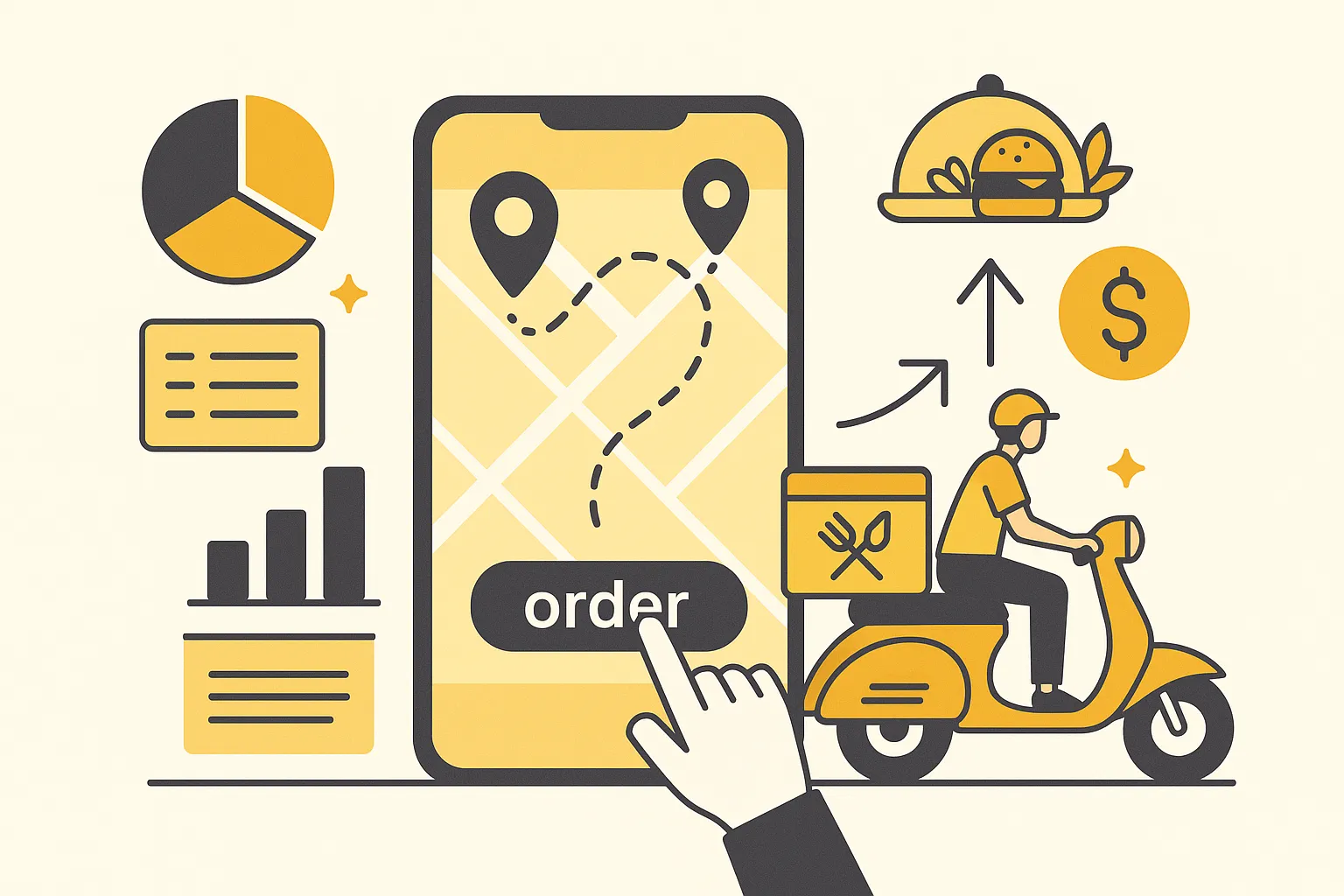Business Model of HungerStation is one of the leading food delivery app in Saudi Arabia and Bahrain, connecting millions of hungry customers with their favorite restaurants in just a few taps. It’s known for its seamless ordering experience, wide restaurant selection, and fast delivery network that keeps users coming back.
If you’re building a food delivery app or exploring on-demand marketplaces, HungerStation’s business model offers smart lessons in scaling, monetizing, and dominating a niche market. This article breaks down exactly how HungerStation operates, earns revenue, and sustains growth—so you can learn from their playbook.
What is HungerStation & How It Works
HungerStation solves a simple but critical problem: getting meals from restaurants to customers quickly and reliably.
Here’s a closer look at how it operates:
- The Problem
Before apps like HungerStation, ordering food meant calling restaurants, dealing with miscommunications, and paying in cash. Customers had limited choices and little transparency over delivery times. - Who Uses It?
- Busy professionals craving convenience
- Families who prefer home delivery
- Millennials comfortable with digital payments
- Restaurants looking to expand reach without building their own delivery teams
- Busy professionals craving convenience
- How the App Works
- Customers browse local restaurants and menus inside the HungerStation app or website.
- They place an order and choose delivery or pickup.
- Payment happens seamlessly via card, wallet, or cash on delivery.
- The restaurant prepares the meal while a courier gets dispatched automatically.
- Real-time tracking shows exactly where the order is and when it will arrive.
- Customers browse local restaurants and menus inside the HungerStation app or website.
The result: a streamlined, reliable, and user-friendly way to satisfy cravings—and an efficient ecosystem connecting customers, restaurants, and couriers.
Read More : What is HungerStation App and How Does It Work?
Target Audience for HungerStation Success
HungerStation’s success comes from understanding exactly who uses the platform—and designing experiences around them.
Here are the main customer segments:
- Urban Professionals
Individuals who work long hours and prefer the convenience of app-based ordering instead of cooking or driving to restaurants. - Families
Households looking for diverse meal options and easy group ordering, especially on weekends and holidays. - Millennials & Gen Z
Digitally savvy consumers who expect seamless payment, real-time tracking, and loyalty perks. - Restaurants & Cloud Kitchens
Eateries that want to boost sales and outsource delivery logistics to a trusted platform. - Independent Couriers
Drivers and riders who partner with HungerStation to earn flexible income by delivering orders.
By catering to these groups, HungerStation has built a robust ecosystem that fuels both customer retention and business growth.
Features that Support the Business Model
HungerStation’s revenue depends on features that drive orders, simplify logistics, and increase customer loyalty. Here are the core features powering their business model:
- Restaurant Marketplace
A searchable directory of thousands of restaurants and cuisines, giving customers variety and making it easy to discover new options. - Real-Time Order Tracking
Customers see exactly where their food is, reducing anxiety and improving satisfaction. - Flexible Payment Options
Supports credit cards, digital wallets, and cash on delivery to serve all customer preferences. - Promotions & Discounts
Targeted offers and coupons encourage repeat orders and higher basket sizes. - Scheduled Orders
Lets users place orders in advance, boosting operational predictability for restaurants. - Loyalty & Referral Programs
Reward points and friend referral bonuses help retain customers and grow the user base organically. - Courier App Integration
A dedicated app for delivery partners ensures efficient dispatching, route optimization, and timely deliveries.
These features don’t just improve user experience—they create multiple touchpoints to monetize each transaction and build long-term customer relationships.
Read More : Best HungerStation Clone Scripts in 2025: Features & Pricing Compared
Revenue Streams of HungerStation
HungerStation makes money through a combination of commissions, fees, and value-added services. Below is a clear table summarizing each revenue stream:
| Revenue Stream | How It Works |
| Commission on Orders | Percentage charged to restaurants for every completed order. |
| Delivery Fees | Charges paid by customers for delivery, often based on distance or order size. |
| Advertising & Promotions | Restaurants pay to be featured or promoted in the app. |
| Service Fees | Small additional fees added to customer orders. |
| Subscription Programs | Premium plans offering free delivery or exclusive discounts. |
| Payment Processing Fees | Margins earned on transactions processed via the platform. |
Quick Explanations:
- Commission on Orders
Typically ranges from 15%–30% of the order value, this is HungerStation’s primary income source. - Delivery Fees
Customers pay extra based on distance, delivery time, or order amount. - Advertising & Promotions
Restaurants can boost visibility by paying for sponsored listings or banner placements. - Service Fees
These nominal charges cover operational expenses and are visible to the customer before checkout. - Subscription Programs
Some users pay monthly or annually to access perks like free delivery. - Payment Processing Fees
A small cut of each card or wallet transaction handled on the platform.
Read more : Revenue Model of HungerStation: How Saudi Arabia’s Food Delivery Leader Drives Profit
Key Cost Sturcture of HungerStation
Running an app like HungerStation involves significant operational and technology expenses. Here are the main costs to consider:
- Courier Payments
The largest recurring cost—paying delivery partners for each fulfilled order. - Customer Support
24/7 support teams handling order issues, refunds, and inquiries. - Technology & Infrastructure
Expenses for app development, hosting, server maintenance, and security. - Marketing & Promotions
Campaigns, discounts, and referral bonuses to attract and retain customers. - Restaurant Onboarding & Partnerships
Costs of acquiring new restaurants and maintaining partner relationships. - Compliance & Licensing
Fees for operating legally across different regions and adhering to regulations. - Payment Processing Fees
Costs associated with handling digital transactions and payouts.
Understanding this cost structure is essential if you’re planning to build a similar delivery platform. Every expense has a direct impact on margins and scalability.
Innovations or Updates strategy
HungerStation is actively evolving to stay ahead of competitors and meet rising customer expectations. Here are some of the most notable recent updates and innovations:
- Express Delivery Enhancements
The company has rolled out improved algorithms for faster order dispatch and delivery times, reducing the average wait to under 30 minutes in major cities. - Subscription Plans Expansion
HungerStation has introduced new tiers of subscription programs with free deliveries, exclusive deals, and priority support for loyal customers. - Sustainability Initiatives
Piloting eco-friendly packaging and options for carbon-neutral deliveries to appeal to environmentally conscious users. - Dynamic Pricing for Delivery Fees
The app now adjusts delivery fees in real-time based on demand surges, similar to ride-hailing models. - Enhanced Restaurant Analytics
Restaurants now get deeper insights into order trends and customer behavior, helping them optimize menus and promotions. - Arabic Language Experience Improvements
Significant investments have been made to improve Arabic content accuracy and personalization across the app experience.
These updates reflect a clear strategy: reduce friction, improve margins, and create more loyalty among both customers and restaurant partners.
Takeaways for Startup Founders
If you’re planning to build a food delivery or marketplace app, HungerStation offers several lessons worth applying:
- Niche Focus Can Drive Market Leadership
By concentrating on Saudi Arabia and Bahrain, HungerStation became the go-to platform for local users. Focused regional strategies often outperform trying to go global too soon. - Diversify Revenue Early
Don’t rely solely on commissions. Combine delivery fees, advertising, subscriptions, and service charges to build a more resilient business model. - Prioritize User Experience
Features like real-time tracking, flexible payment, and reliable delivery logistics are crucial to customer retention. - Invest in Restaurant Relationships
Success depends on a strong network of restaurant partners. Make onboarding easy and give partners tools to grow their sales. - Embrace Technology and Data
Use smart algorithms for dispatch, dynamic pricing, and personalized offers to boost efficiency and customer loyalty.
If you want to bring your own delivery platform to life, Miracuves can help you get there faster. Our ready-made UberEats Clone and Food Delivery Solutions give you:
- Pre-built apps for customers, couriers, and restaurants
- Scalable technology that supports thousands of orders
- Custom branding and feature extensions
- Ongoing support to keep improving your product
Read more : Reasons startup choose our HungerStation clone over custom development
Conclusion :
HungerStation’s business model proves that smart technology, local market focus, and a mix of revenue streams can build a thriving on-demand delivery platform. From flexible payment options to subscription perks and data-driven operations, every piece of the puzzle supports profitability and customer loyalty.
If you’re ready to build your own delivery app inspired by HungerStation’s success, Miracuves can help you launch faster and smarter.
Let’s build your food delivery empire together.
Contact with Miracuves and explore our Uber Clone Solutions and Ready-Made Food Delivery Apps tailored for ambitious founders like you.
FAQs :
1. How does HungerStation make money?
HungerStation earns revenue mainly through commissions charged to restaurants on every order, delivery fees paid by customers, advertising placements, and subscription plans. This diversified approach helps sustain profitability and reduces reliance on any single stream.
2. What sets HungerStation apart from other food delivery apps?
HungerStation focuses specifically on Saudi Arabia and Bahrain, offering a deeply localized experience. Features like Arabic language optimization, tailored promotions, and regional restaurant partnerships make it the preferred choice in its markets.
3. Can I build a similar app for my region?
Absolutely. With the right development partner, you can launch a branded delivery platform with features like real-time tracking, dynamic pricing, and subscription models. Miracuves offers ready-made solutions to help you go live faster.
4. What are the biggest operational challenges?
Key challenges include managing courier logistics, maintaining high customer satisfaction, ensuring payment reliability, and staying compliant with regional regulations.
5. How do restaurants benefit from partnering with HungerStation?
Restaurants gain access to a large customer base without investing in their own delivery infrastructure. They also get valuable data insights and marketing opportunities to boost visibility and sales.
Related Articles :








